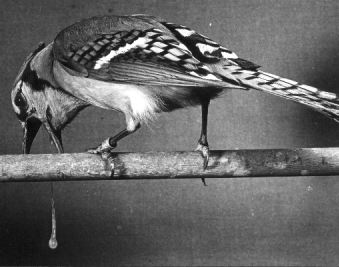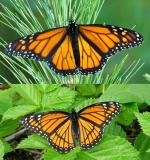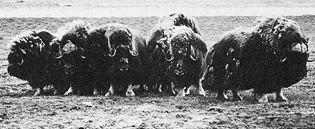15.11.6: Avoiding Predation
- Page ID
- 5768
Most animals get their food from preying on other organisms, and much of the life of animals involves eating and avoiding being eaten. So it is not surprising to find many examples of adaptations that increase the effectiveness of predation and minimize the risk of being preyed upon. We shall examine some of the devices that help their owners avoid being eaten.
Camouflage (cryptic coloration)
Many animals are patterned to blend in with their surroundings. Some examples include the peppered moth and the winter flounder.
Masquerade
Masquerading animals resemble some inanimate object and thereby escape detection by potential predators (or prey).

The motionless twig caterpillar shown here (courtesy of Muriel V. Williams) complete with "buds" and "lenticels" escapes detection by birds (but pays for its cleverness by occasionally having some other insect lay eggs on it by mistake).
Chemical Defenses
Many plants and animals use repellent chemicals to deter predation. Millipedes secrete hydrocyanic acid when disturbed. Some beetles squirt potential predators with such mixtures as 85% acetic acid or 40% formic acid. The discharge of the skunk is another familiar example.But what if you have a powerful defensive weapon but no potential predator notices until it has launched an attack? One solution to this dilemma is the evolution of warning coloration (also called aposematic coloration).
Aposematic Coloration

This is the larva of the monarch butterfly; an example of aposematic coloration. There is no question of camouflage here. Rather this creature is advertising its presence. The milkweed leaves on which it is feeding contain cardiac glycosides that are toxic to vertebrates because they block the activity of the Na+/K+ ATPase that is essential for many cell functions. The larva stores these within its body and thus becomes unpalatable to vertebrate predators. The chemicals remain in the body even after metamorphosis, so that adults are unpalatable as well.


In these photographs (provided by Lincoln P. Brower) a blue jay eats a portion of a monarch butterfly (left) that had fed (in its larval stage) on poisonous milkweed. A short time later, the blue jay vomits (right). Following this episode, the blue jay refused to eat any other monarch offered to it.
Mimicry
Batesian Mimicry
If an animal is not noxious to potential predators, why not look like an animal that is? Some examples:
- A number of harmless snakes closely mimic the bright warning coloration of the coral snake — the most poisonous snake in the United States.
- The harmless robber fly (right) resembles the bumblebee (left) even though the two are not closely related. The robber fly is a dipteran, with only a single pair of wings, while the bumblebee is a hymenopteran with two pairs.
- The viceroy butterfly (bottom) contains no toxic substances in its body and presumably is quite palatable (one entomologist declared it tastes like dried toast). If so, the viceroy's striking resemblance to the monarch (top) enables it to capitalize on the monarch's unpalatability. (Photos by, and courtesy of, Howard Hoople.)
This phenomenon is called Batesian mimicry (named after Henry W. Bates, a nineteenth-century naturalist who studied many such cases).


Müllerian Mimicry
Some unpalatable animals closely resemble other equally unpalatable species. Such mimicry is called Müllerian mimicry (in honor of the German zoologist Fritz Müller, who studied it). Presumably each species gains a measure of protection from the occasional, but educational, losses of the other species to predators. Lincoln Brower, who has studied the monarch and viceroy, believes that the viceroy is as unpalatable to potential predators as the monarch, and thus is really an example of Müllerian mimicry.
Aggressive Mimicry
Some carnivores have evolved devices with which they mimic the prey (or potential mate) of other (usually smaller) predators. They use these devices as lures.
Two examples:
- The angler fish (Antennarius) displays a lure resembling a small fish. The lure is a development of the spine of the first dorsal fin. This species of anglerfish, which was found in the Philippines, is 9.5 cm long. Note its use of camouflage: its texture (and color) closely resemble the sponge- and algae-encrusted rocks found in its habitat.

Fireflies use their flashes to attract mates. The pattern differs from species to species. In one species, the females sometimes mimic the pattern used by females of another species. When the males of the second species respond to these "femmes fatales", they are eaten!
Group Behavior
Cooperation between members of a social species often reduces the severity of predation. Grazing ungulates are usually organized so that the stronger are on the outside of the herd, the weaker within.

In this photo (courtesy of Ted Grant, National Film Board of Canada), musk oxen have responded to a threat by forming a circle with the females and young in the center. Both herds of ungulates and flocks of birds often have members who are extra-watchful, ready to give the alarm if danger threatens. When alarmed, smelt (a kind of fish) release a pheromone into the water that warns other members of the school. When a honeybee stings an intruder, she release isoamyl acetate, which excites other bees to join the attack.


